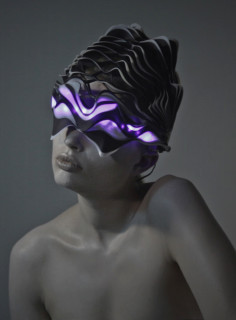Behnaz Farahi
Synapse

source: behnazfarahi
Synapse is a 3D-printed helmet which moves and illuminates according to brain activity. The project was made with support from Autodesk Pier 9, and the USC School of Cinematic Arts.
shape in response to the activities of the brain. The main intention of this project is to explore the possibilities of multi-material 3D printing in order to produce a shape-changing structure around the body as a second skin.
Additionally, the project seeks to explore direct control of the movement with neural commands from the brain so that we can effectively control the environment around us through our thoughts.
The environment therefore becomes an extension of our bodies. This project aims to play with the intimacy of our bodies and the environment to the point that the distinction between them becomes blurred, as both have ‘become’ a single entity.
The helmet motion is controlled by the Eletroencephalography (EEG) of the brain. A Neurosky’s EEG chip and Mindflex headset have been modified and redesigned in order to create a seamless blend between technology and design.
EEG technology allows the recording and monitoring of the electrical activity of the brain, produced from the firing of neurons.
Neurosky’s EEG technology has the ability to assess cognitive load and measure various data such as Attention, Meditation, Delta, Theta, Low Alpha, High Alpha, Low Beta, High Beta, Low Gamma, and High Gamma values. The neural commands related to the “Attention” level are therefore translated into actual motions. This operates as a direct interface that allows users to interact with their immediate and non-immediate environments.
The 3D-printed helmet was produced using Object Connex 500 multi-material 3D printing technology at Pier 9, Autodesk, which is able to print a soft (black) and hard (white, in this case) in a single operation.The design of the helmet aims to provide a flexible/soft structure which enables maximum contraction and expansion.
.
.
.
.
.
.
.
source: behnazfarahiprosite
Behnaz Farahi is a designer, architect, and Annenberg Fellow at the USC School of Cinematic Arts. She is interested in interactive environments and their relationship to the human body. In particular she is interested in the integrated application of material performance, and smart materials in contemporary art/architecture practice. Behnaz Farahi has an Undergraduate and two Masters degrees in Architecture, and is now a PhD candidate on the Media Arts and Practices program at USC.
Behnaz Farahi has also worked with Professor Behrokh Khoshnevis on a NASA funded research project developing a robot to print structures on the Moon.
Her work has been widely published and exhibited. It has been selected for Skyline2014 in Downtown Los Angeles, ACADIA 2013 conference in Canada, ‘Sight+ Sound+ Space’ iMAP exhibition in 2013, ‘Design Intelligence: Advanced Computational Research’ exhibition in Beijing in 2013, the ‘Encoding Architecture’ exhibition in Carnegie Mellon University in 2013. In 2013 she was awarded first prize for the Kinetic Art Organization international competition.
.
.
.
.
.
.
.
source: behnazfarahi
Exploring the potential of interactive environments and their relationship to the human body, Behnaz Farahi is interested in the implementation of emerging technologies in contemporary art/architecture practice. Her goal is to enhance the relationship between human beings and the built environment by implementing design/motion principles inspired by natural systems. Application areas include architecture, fashion and interaction design. She also specializes in additive manufacturing and robotic technologies.
Her work has been exhibited internationally (most recently at Ars Electronica, Linz) and has been featured in several magazines and online websites including WIRED, BBC, CNN, The Guardian, Motherboard, Dezeen, Frame Magazine, The Creators Project and many more. Behnaz Farahi has won several awards including Innovation By Design Linda Tischler Award and is the recipient of the Madworkshop Grant and the Rock Hudson Fellowship.
Farahi has worked with leading firms such as Autodesk, Fuksas Studio, and 3DSystems / will-i-am. She has also collaborated with Professor Behrokh Khoshnevis on two NASA funded research projects developing a robotic fabrication technology to 3D print structures on the Moon and Mars.
She has been an Artist in Residence at Autodesk Pier 9. Currently she is an Annenberg Fellow and PhD candidate in Interdisciplinary Media Arts and Practice at the USC School of Cinematic Arts. She has a Bachelor’s and two Masters degrees in Architecture.
.
.
.
.
.
.
.
source: jianzhubang
Behnaz Farahi是一名建筑师,在其家乡伊朗阿扎德大学获得建筑学本科学位,并于伊朗沙希德·贝赫什提大学和美国南加州大学获得双硕士学位。她目前在南加州大学攻读iMAP电影艺术学院的博士学位(跨学科媒体艺术与实践)。
为了探索交互环境的潜力,以及它们与人体之间的关系,BehnazFarahi对新兴技术在当代艺术/建筑实践探索有着浓厚的兴趣。她的目标是通过实现受自然系统启发下的设计/动机原理,进而加强人类与建造环境之间的关系。她所涉及的领域包括建筑、时尚与交互设计,同时她在增材制造与机器人技术领域中同样有相关研究。
她的作品在美国、加拿大、中国等进行全球展出,并在一些杂志与网站包括WIRED,The Guardian, BBC, CNN, Motherboard, Dezeen, Frame Magazine, The CreatorsProject等均有刊登。Behnaz Farahi获得了众多奖项,并且是MADWORKSHOP津贴补助者与洛克·哈德森奖学金获得者。Behnaz Farahi与Autodesk, Fuksas Studio, and3DSystems / will-i-am等龙头企业有着合作关系,同时在NASA基金资助的关于探究发展月球与火星上机器人建造技术到3D打印结构课题中与Behrokh Khoshnevis教授也有合作。
一个以人的身体与环境,心理与行为,机器人技术与3D打印技术为核心课题的研究会有怎样惊艳的成果作品呢?下面则对Behnaz Farahi的研究成果进行展示介绍,揭开设计女神的神秘面纱。
“极光”是一个回应它下方的物质运动的交互的动态吊顶。这个项目是MEML实验室和SteelCase公司联合研究的一部分,旨在探索建成环境的未来。
一个建筑怎样能够具有动态特性,并且通过对其使用者的运动进行解读并作出相应的回应?在当今世界随着感知环境的进步,我们对于空间的感知如何能够通过人工智能技术进行增强?我们如何将人体运动作为交互的一种手段与人造环境进行互动?建筑的空间是否有可能与互动性、不可预知性和运动性相结合,以作为一种动感的界面,传递着居住者们活动的故事?还有,动感柔软的未来建筑是否有可能通过表面传递使用者的活动信息,就好像人们可以通过观察海洋的表面,感知风的方向一般?
“极光”尝试着通过一个交互性天花板装置解决这些问题。这个作品最主要的目的是去探测使用者的身体运动并根据此进行重新组合。通过使用运动捕捉相机跟踪使用者的身体运动并将其翻译成针对不同运动的设计,这个项目试图对身体化的互动有了更深的理解,并去制造更多直觉性的互动体验。
它旨在通过对形状改变的形式、回应式的灯光、可适应性的空间和交互反映的结合,去重新思考常规的、刚硬坚固的建筑空间,因此它是一个去重新想象感知空间与机器人建筑可能性的尝试。
装置名称取自罗马的破晓女神——极光。正如女神每个清晨焕然一新,飞过天空并宣告朝阳的来到,“极光”装置欲带来美好生活、点亮世界。相应地,设计包含了一系列可基于它下方人们的活动而亮起来的浮盘。这个实验性的结构是通过一系列关于动态变形结构、机器人、材料性能、膜结构、镶板和切削技术以及控制器交互系统的研究而被发展形成的。这些探索利用了设计、科技、机械以及建造之间的联系。
.
.
.
.
.
.
.
source: excitecojp
もともと体の一部だったかのように脳波で開閉するヘルメット
美しい女性の頭に装着された奇妙なヘルメット。これは、脳波で自由に開閉できるようになっている。
両耳に取り付けたセンサーを介して、有機的に動く様はまるでもともと人間の身体の一部だったかのようだ。
女性の首元や指の動きを合間に挟みながら、身体と一体化しているような印象を私たちに与えてくれるこのヘルメットは、ロサンゼルスに住むデザイナー、Behnaz Farahi氏が発表した『Synapse(シナプス)』と呼ばれるもの。
脳波センサーを提供しているのは、あの『脳波で動く猫耳ヘッドセット』を開発したニューロスカイだ。同社は、生体信号センサーやブレインコンピューターインターフェイスの研究を一般市場に広げようと1999年に設立され、医療などの現場で役立つモジュールやコミュニケーションツールを開発している。
そして『Synapse』にはもう一つ、注目すべき技術が使われている。みなさんも気になっていたであろう、その“素材”である。…

